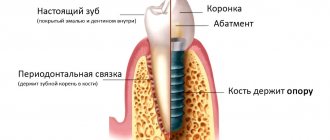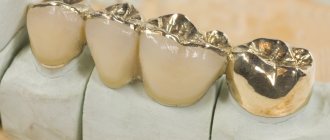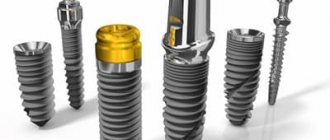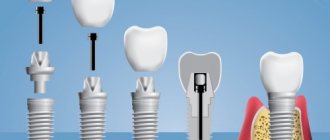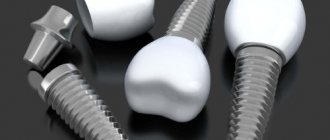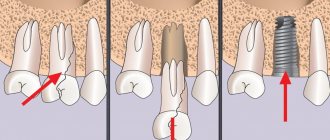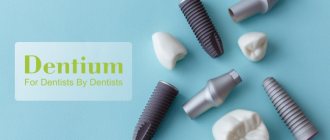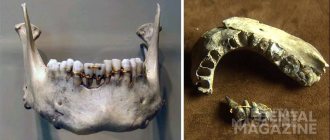Single-stage, immediate, or immediate dental implantation, which is also called instantaneous, is a procedure that requires certain knowledge and skills from the dentist. At the same time, this type of operation today is a favorite technique of both specialists and patients, since, if all norms and rules are observed, it guarantees a long-lasting result and high aesthetics. How does one-stage implantation differ from classical implantation and what are its advantages, says Roman Gennadievich Yaryshev, chief physician and implant surgeon at Meira Dental Clinic in Moscow.
What is one-stage dental implantation?
Single-stage, or instant, implantation is a type of dental restoration where immediately after a tooth is removed, an implant is installed in its place, and all this happens during one visit. Single-stage implantation is most in demand when restoring teeth in “visible” areas, that is, where aesthetics are so important, namely in the smile area.
From a functional point of view, implantation immediately after tooth extraction is more preferable than a two-stage technique in cases where it is necessary to simultaneously restore several teeth. In such a situation, the instant technique significantly reduces the patient’s rehabilitation time, and also allows the installation of a temporary structure with which the patient can chew without problems and immediately.
Recovery postoperative period
After the operation, the recovery period begins, the person has solved his problem and now there is an implant instead of a damaged tooth. How to care for it and what should you be wary of on the doctor’s recommendation until the tooth finally begins to feel like your own?
For the first few days, the patient will experience slight swelling, which will cause discomfort. This is normal because surgery was performed. It is worth avoiding excessive chewing loads during this period and carefully monitoring oral hygiene using special antiseptics. During the first month, the discomfort goes away, and the patient forgets that he has an implant installed.
Installing an implant immediately after tooth extraction - types of surgery
There are three main types of this procedure for restoring teeth immediately after their removal. The first is instant implantation, when after installing the implant, the gums in the place of the just extracted tooth are sutured, and further manipulations are performed only after complete healing. In the second case, during immediate implantation, in addition to the implant itself, the patient is also fitted with a gum former, which helps in the future to preserve the so-called “pink aesthetics”, that is, the natural and neat appearance of the soft tissue at the implantation site. Gum formers can be standard or custom-made; which one to choose depends on the situation.
Before and after immediate dental implantation. Works by Yaryshev R.G.
The third type of one-stage jaw implantation is the installation of an implant in place of an extracted tooth with immediate loading of the latter with a temporary crown. After the implant has healed, this temporary crown is replaced with a permanent one. This subtype of instant implantation is by far the most effective from an aesthetic point of view, as it allows you to fully restore the pleasant appearance of your smile in one visit, so that the patient does not have to walk around with a “hole” in the dentition for the entire healing period. This type of express implantation is most in demand when restoring teeth in the smile zone, that is, in the anterior region.
Make an appointment
right now!
Yaryshev Roman Gennadievich
Surgeon, Implantologist
How is the All-on-6 surgical stage performed?
We have already said above that the surgical stage of All-on-6 implantation implies that the implants are installed in the teeth position 6-4-2|2-4-6. The installation of implants can be carried out using 2 different types of surgical techniques, which will greatly affect the duration and traumatic nature of the operation. We have the following 2 surgical techniques with which All-on-6 implantation can be performed...
- using a surgical template,
- classical technique (without using a template), which implies the need to make incisions in the gums and detach the mucoperiosteal flaps from the bone - followed by suturing at the end of the operation.
a) Implantation with an individual surgical template –
For the patient, this is the most non-traumatic and comfortable version of the operation, and in this case, for the installation of 6 implants, about 45 minutes will be enough for us. An individual surgical template is something like a transparent mouthguard, which at the beginning of the operation is fixed to the toothless jaw using pins. In such a template, special guides will be made for the pilot drill or cutters, with the help of which the implantologist will form a bed for each of the implants.
This template is individual for each patient, and the position of the guides for the pilot drill and cutters is calculated and modeled in a special program on the computer where your CT scan is loaded. Thus, taking into account the topography of the bone tissue in the image, we can model the ideal position of the implants in the jaw, and then the position of the guides in an individual surgical template (this can be a “Nobel Guide” or similar).
All this will allow us to install 6 dental implants in the ideal position - without making incisions and peeling mucoperiosteal flaps from the bone. We will install implants only by making small holes in the mucous membrane. But, if we didn’t have a template, then the implant surgeon would have to see the surface of the jaw bone tissue with his eyes to install implants, and for this he would need to peel off the flaps (gum) widely.
Operation progress (with Nobel Guide template) –
Advantages of surgery with the NobelGuide surgical template:
- The operation lasts only about 45 minutes,
- no need to peel off mucoperiosteal flaps - makes the operation not only quick, but also easily tolerated even in elderly patients, and in addition - in the postoperative period there will be no severe pain, hematomas, swelling of the soft tissues of the face,
- the risk of complications (injury to nerves, maxillary sinuses) is reduced due to the fact that the template allows you to bypass dangerous anatomical formations,
- very often, the presence of a template allows you to do without bone grafting (even in patients with severe bone volume deficiency) - due to super-precise positioning of implants in the jaw bone tissue,
- This implantation technique can be performed even in patients with osteoporosis and diabetes mellitus, and is also optimal for patients with a complicated medical history (for example, in the presence of cardiovascular and other diseases).
b) Classic All-on-6 technique with flap detachment –
If we do not make a custom surgical guide, then to install the implants we will need to see the surface of the bone, which means we will simply have to make incisions and widely peel the gum from the bone. Below we will show you the progress of the All-on-6 operation on the upper jaw, where at the time the operation began, the patient had 6 front teeth with a high degree of mobility in the jaw (these teeth were removed at the very beginning of the surgical operation).
Classic technique of All-on-6 implantation –
* Please note that in addition to removing mobile teeth, the surgeon made incisions along the alveolar ridge of the jaw, after which mucoperiosteal flaps were detached from the bone. After this, the patient had 6 Straumann BLT implants installed, and the gums were sutured. It is worth noting that in this patient the flaps were folded back quite sparingly, because The patient had no noticeable loss of bone volume. Usually the flaps are folded back much wider, and this is what causes quite severe pain, swelling and bruises after surgery.
In addition, the need for flap detachment also leads to a longer healing period. Stitches applied are usually removed on the 10th day. And at the very end of the operation, the implant surgeon will screw the so-called “Multi-unit” abutments into the implants, which are the gold standard for permanent prosthetics of toothless jaws. Immediately after fixing the multi-unit abutments, the patient is sent to an orthopedic dentist for the manufacture of a temporary fixed adaptive prosthesis.
Immediate dental implantation and its benefits
Ensuring a beautiful appearance, especially in the frontal area, is no less important than restoring the functions of speech and chewing, and the already mentioned “pink aesthetics,” that is, a neat contour of the gums, is no less important than the correctly selected color and shape of an artificial tooth. The advantage of one-stage jaw implantation is that, regardless of whether we load the implant with a temporary crown or install a gum former, we maintain the original contour of the soft tissues. In the case of two-stage implantation, this circuit has to be restored from scratch after the implant has completely healed, which not only forces the patient to endure inconvenience during the rehabilitation period, but also does not guarantee an ideal result in the future. As for monetary costs, the price of one-stage implantation in Moscow does not exceed the cost of surgery using the classical method.
Before and after immediate dental implantation. Works by Yaryshev R.G.
Review statistics among specialists and patients
The one-stage prosthetics method began to be used in Russia relatively recently, while in Europe such services have been provided for several years. Analyzing world statistics, you can see that this method has collected a large number of positive reviews and enjoys well-deserved trust among both doctors and patients. The problem of a missing tooth is solved in record time.
Single-stage implantation also perfectly solves the aesthetic component of the problem: there are patients who do not like the look of their own teeth. They delay visiting the dentist and go without a tooth for a long time, not deciding on implantation. In addition, many people think that implantation takes a long time and are unable to find a place for the procedure due to their busy work schedule. However, the procedure is performed quickly and the installed tooth will look aesthetically pleasing and natural. Negative reviews can only be found regarding dissatisfaction with the price: the procedure is not budget-friendly and not everyone can afford it.
What are the contraindications to immediate dental implantation?
Unfortunately, immediate implantation is not always the best option, since in some cases it is not possible to install an implant immediately after tooth extraction. For example, immediate implantation is not carried out when inflammation is observed at the site of the extracted tooth. Also an obstacle are standard contraindications to implantation, be it decompensated diabetes mellitus, severe bruxism, or uncontrolled grinding of teeth, some other chronic diseases in the acute stage or relapse, osteoporosis, heart attacks suffered less than six months ago, strokes and hypertensive crises. Smokers are also at risk. Although smoking is considered a relative, and not an absolute, contraindication, it may well cause implant failure.
In a number of other cases, immediate installation of an implant in place of an extracted tooth is possible, but immediate loading of it with a temporary crown is, unfortunately, not. Such situations include, for example, traumatic tooth extraction, a small volume of bone and soft tissue in the area where the implant is installed and its insufficiently reliable fixation in the socket, as well as a soft bone structure. In such cases, an aesthetic result is achieved by installing a gum former and attaching a temporary orthopedic structure to the teeth adjacent to the defect, hiding the “hole” in the dentition.
Before and after immediate dental implantation. Works by Yaryshev R.G.
Which implant is better to place? Let's compare Dentium, MIS and Nobel implants
The optimal solution for tooth loss is dental implantation. The cost of this procedure varies greatly, largely depending on the implant chosen. Artificial roots for future teeth can vary in cost several times.
Let's look at 3 common implantation systems from different price categories.
Implant | Dentium | M.I.S. | Nobel |
Line of implants | Dentium SuperLine | MIS M4, MIS Seven | Nobel Activ |
Manufacturer | Dentium Co, South Korea | Medical Implant System, Israel | Nobel Biocare, Switzerland |
Survival rateStarSmile rating data is provided. The survival rate of budget implants may be overestimated due to the fact that doctors prefer to place them only under good clinical conditions. And more technologically advanced and expensive systems are installed in patients with bone grafting, chronic diseases, etc. | 98% | 97% | 99,3% |
Survival rateData provided by CosmoStom | 98,1% | 98,3% | 99% |
Lifetime WarrantyGuarantee of free implant replacement in case of rejection. | + | + | + |
VersatilitySuitable for narrow interdental spaces, etc. | + | + | + |
Atraumatic apexAre there models with a flat top, which are installed when there is a high risk of injury to the mandibular nerve or maxillary sinus? | + | + | + |
CompoundThe connection to the hexagon-shaped abutment ensures high tightness. | + | + | + |
Reviews from independent expert organizationsResearch data from the independent non-profit international scientific organization POSEIDO (Switzerland, Geneva). In 2014, the organization examined 62 implant models. | “Dentium Superline (DentiumCo., Seoul, Korea) is a sandblasted/acid etched surface. Inorganic contamination of the surface with silicon was detected. The surface is moderately micro-rough, nano-smooth, homogeneous throughout the entire body of the implant.” | “Implant surface sandblasted and acid-etched with ultra-pure 23 titanium alloy with extra low impurities. There were no signs of contamination or chemical modification of the surface." | “TiUnite (Nobel Biocare, Gothenburg, Sweden) is an anodized surface with a thick layer of titanium dioxide TiO2 (>100 nm). The surface is chemically altered by integrating large amounts of phosphorus during anodization. Inorganic surface contamination with fluorides and sulfates was also detected. The surface is microporous (pores are formed during anodization), smooth at the nanolevel with extended cracks that appear during the anodization process.” |
Other research and awards | No data | In 2015 - the best results according to the criteria for processing and cleaning the surface of implants in a medical study. University of Cologne (Germany). In 2021, the Congress of the Academy of Osseointegration (Los Angeles, USA) awarded MIS with the “CLEAN IMPLANT FOUNDATION” award - as a system with a perfectly clean implant surface | “The rough surface of TiUnite implants has been described in more than 275 publications based on the results of clinical studies involving more than 13,000 patients, using 42,000 implants and a follow-up period of up to 12 years,” the Nobel website reports and provides links to study data. |
Patient information supportAvailability of an official Russian-language website with useful information that can be understood without medical education. For patients, this is an opportunity to receive a qualified, reliable answer to their questions without repeated visits to the doctor. | — | + | + |
In the worldData on the prevalence of the implant in different countries of the world are indicated for 2021. Information taken from the official websites of manufacturers. Widespreadness indicates the recognition of the brand by doctors around the world. This factor is also important for those patients who are planning to move to another country. | Russia, China, Canada, Australia, etc. 10 countries + European Union. | 72 countries of the world | The most common brand of implants in the world. |
Own developmentsThe company develops innovative technologies in the field of implantology, and not only uses existing ones. | No data | + | + |
Surface | Rough SLA surface – sandblasting using coarse abrasive + acid etching. Proven and most widely used technology. | Rough SLA surface – sandblasting using coarse abrasive + acid etching. Proven and most widely used technology. MIS use well-known technology, but have brought its result to an ideally pure level. | Unique patented oxidized TiUnite surface |
All-on-4Prosthetics on 4 implants with complete absence of teeth | + | + | All-on-4 technology was developed by Nobel Biocare. Nobel implants are ideal for this type of treatment. |
Start of data collectionShows how long the company conducts research and observes the behavior of its implants after installation, long-term consequences and service life. | 2000 | 1995 | 1962 |
Summary | Dentium are inexpensive implants for most clinical cases. | MIS are universal implants with the cleanest surface, used when there is a risk of rejection. | Nobel - high-tech premium implants for complex clinical situations. |
Risks of instant dental implantation
To be absolutely frank, we have to admit that with one-stage implantation, the percentage of implant rejection is slightly higher than with two-stage implantation, but this percentage still remains negligible (provided that all standards are met). Moreover, this risk is justified, especially in cases where a quick, highly aesthetic result is required. In general, the risk of implant rejection when installed using one-stage technology is associated with the following factors:
- severe gum injury after tooth extraction;
- accumulation of plaque around the hole not protected by the gum;
- not very strong implant fixation;
- immediate loading of the implant with a temporary crown.
Price
The technique of one-stage implantation requires the use of high-quality materials and modern equipment. In addition, the highly qualified implantologist is very important. The total cost of the procedure consists of consumables, the level of the doctor and the clinic. If the clinic has its own dental laboratory, the cost of the implant will be significantly lower. The average price for a turnkey installation is 45 thousand rubles. The service life of implants reaches 25 years, provided that high-quality materials are selected and the procedure protocol is strictly followed. The best implants are those made in Sweden, Israel and the USA.

